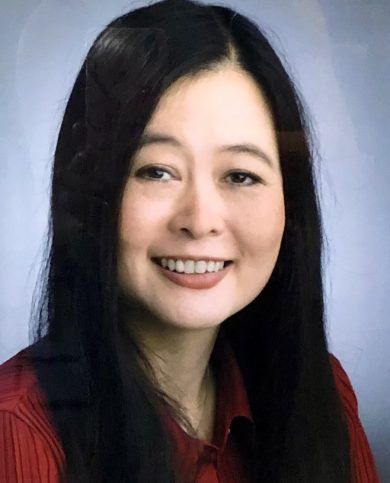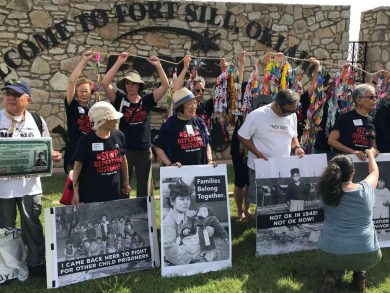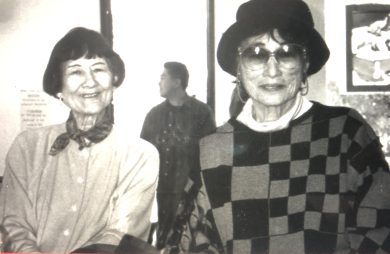 Dr. Alice Yang is Chair and Associate Professor in the History Department at UC Santa Cruz. She is a 2022-2023 THI Faculty Fellow in Public Humanities, Digital, and Community-Engaged Research, and currently serves as the Co-Director for the Center for the Study of Pacific War Memories. She previously served as a Faculty Mentor for THI’s Questions That Matter Teaching Program on the theme of Futures. Dr. Yang is working on a book project tentatively titled Stop Repeating History: Japanese American Women, Memories of the World War II Incarceration, and Contemporary Transnational Antiracist Activism, which explores the role of Japanese American Women in redress movements and coalitional antiracist activism. In May, we discussed the importance of multiethnic, multiracial, and transnational campaigns to defend human rights, as well as Dr. Yang’s approach to mentorship and community-engaged public scholarship.
Dr. Alice Yang is Chair and Associate Professor in the History Department at UC Santa Cruz. She is a 2022-2023 THI Faculty Fellow in Public Humanities, Digital, and Community-Engaged Research, and currently serves as the Co-Director for the Center for the Study of Pacific War Memories. She previously served as a Faculty Mentor for THI’s Questions That Matter Teaching Program on the theme of Futures. Dr. Yang is working on a book project tentatively titled Stop Repeating History: Japanese American Women, Memories of the World War II Incarceration, and Contemporary Transnational Antiracist Activism, which explores the role of Japanese American Women in redress movements and coalitional antiracist activism. In May, we discussed the importance of multiethnic, multiracial, and transnational campaigns to defend human rights, as well as Dr. Yang’s approach to mentorship and community-engaged public scholarship.
Hello Professor Yang! Thanks for chatting with us about your research and all the wonderful humanities work you’ve been involved in. Congratulations again on being named a 2022-2023 THI Faculty Public Humanities, Digital, and Community-Engaged Research Fellow! Your project, “Stop Repeating History: Japanese American Women, Memories of the World War II Incarceration, and Contemporary Transnational Antiracist Activism,” includes developing an exhibit and website documenting the history of resistance by Japanese American women during and after World War II, along with accompanying community outreach programs. Could you update us about the evolution of this project and what you are currently focused on?
Thank you. I’m very grateful for THI support for this project. It evolved out of research I conducted for my book on the movement that obtained the passage of the Civil Liberties Act of 1988 providing a national apology, a public education fund, and individual payments of $20,000 for Japanese American incarcerees. Women played a critical role in this struggle for redress and had a long history of activism on behalf of themselves, their families, and the community. I want to pay tribute to this history of resistance by multiple generations of women throughout the last 8 decades. I’ve had the honor of interviewing some of these amazing women and hope the project conveys why all of us should be inspired by their commitment to fighting injustice. Showing the powerful connection between the past and the present, the exhibit will highlight how women’s historical memories helped gain passage of bipartisan redress legislation, challenged racial and gender stereotypes, promoted intergenerational ties, and developed coalitions with other communities fighting discrimination based on race, national origin, religion, gender, immigration status and sexual orientation. I’m currently in the process of collecting photographs, artifacts, oral histories, and videos of women showing how and why they have invoked memories of the mass incarceration and redress in their transnational antiracist activism.
Part of your project explores the continued efforts by Japanese American women to prevent other people of color from experiencing racial profiling and unjust detention in the last two decades, and their support of reparations efforts for African Americans and military sexual slaves under Japanese colonialism. Why is it so important to trace these intersectional coalitions? What can contemporary antiracist activists learn from the histories of resistance you are studying?

Former incarcerees Protest at Fort Sill.
As historians, we can help document the powerful impact of multiracial coalitions on social, cultural, and political resistance. Many Japanese American women activists were shaped by civil rights, antiwar, anticolonial, and feminist demonstrations. Denouncing the “model minority” myth that claims Asian Americans were apolitical and overcame racism solely through hard work, they’ve emphasized continuing discrimination against Asian Americans and other people of color. They believe the legacy of Japanese American redress must include educating the public about how slavery and white supremacy has caused current structural inequality. They’ve supported the struggle for African American reparations and demands that the Japanese government provide redress for military sexual slaves. Contemporary antiracist activists can learn from their experiences developing multiethnic, multiracial, and transnational campaigns to defend human rights. Recent examples include court challenges of Trump’s Muslim travel ban and the successful effort to prevent plans to separate undocumented family members at Fort Sill.
You currently serve as the co-director of the Center for the Study of Pacific War Memories. Why is it important for you to engage in this kind of interdisciplinary research collaboration? Could you share one discovery you made, or relationship you formed, or perhaps an event you participated in during your time spearheading this center that felt particularly special to you?

Bay Area activists Chizu Iiyama and Kiku Hori Funabiki.
I’m proud of the way the Center has sponsored interdisciplinary research. The most prominent project sponsored by the Center has been the Okinawan Memories Initiative, a collaboration between faculty, graduate students, and undergraduates at UCSC, CSU Monterey Bay, CSU East Bay, and the University of the Ryukyus. Our archival specialists, oral historians, filmmakers, photographers, and artists have conducted fieldwork, mounted exhibits in the US and Okinawa, and developed public programming on the history of Okinawa and the Okinawan diaspora. We’ve also created a digital archive, conducted oral histories, and supported the Okinawan Association of America. I had the privilege of participating in an interview with Masako Arakaki, who as an 8-year-old girl was photographed by Charles Gail, an army dentist, when he was stationed in Okinawa in 1951. After the Ryukyu Shimpo newspaper published a story on an exhibit of Gail’s photographs and included Arakaki’s photo, she approached us and agreed to be interviewed. Her oral history includes her perspectives on growing up in the 1950s, relations between the US and Japan, and the militarization of Okinawa. The interview received widespread publicity in the Okinawan press and was filmed by NHK, a Japanese public media broadcaster.
In 2019-2020, you served as a Faculty mentor for the THI Questions That Matter Course on Futures. What drew you to this role? Why is it important to provide humanities graduate students with pedagogical mentorship?
THI has done a wonderful job of encouraging innovative research, teaching, and public programming.
THI has done a wonderful job of encouraging innovative research, teaching, and public programming. As a historical memory specialist, I’d had a lot of experience studying and teaching about connections between views of the past and the present. I had not, however, spent as much time exploring how perceptions of the future might affect our understanding of the present and the past. I also was excited by the prospect of learning more about the ways speculative fiction has envisioned different possible futures. Before I went to graduate school to study history, I had majored in literature and I’m a big fan of science fiction. I saw the program as an opportunity to examine how our society might imagine scientific and technological change, threats to the environment, and constructions of race, religion, gender, and sexuality in the future. I was really impressed by the knowledge and dedication of the graduate students who were selected to serve as instructors for these courses. I learned a lot from working with the other faculty mentors, the peer mentors, and the graduate student instructors for the Data and Democracy and the Futures courses. Kirstin Wagner, Taylor Wondergem, and Courtney Kersten did a phenomenal job of designing syllabi that engaged undergraduates with a variety of backgrounds and interests. Students learned how to read critically, analyze arguments, assess textual evidence, and provide creative and analytical responses in discussions and literary, journalistic, and scholarly written work.
While I and the other faculty mentors could give feedback and advice based on our teaching experience and familiarity with UCSC undergrads, we really benefited from learning from the Graduate Student Instructors.
I loved the way this cohort of graduate students collaborated and developed assignments that encouraged students to be creative in their final projects by giving them choices from a range of topics and formats. They could study capitalism or the future of capital, climate change, afrofuturism, reproduction, abolition, militarism, gentrification, displacement, and migration. They could write a piece of science fiction, create a short film, webpage, or podcast, or explore the course content and concepts through poetry or another art form. They could work individually or collaboratively. Giving students these choices empowered them and exemplified the kind of skill development that reflects the best of humanities teaching. While I and the other faculty mentors could give feedback and advice based on our teaching experience and familiarity with UCSC undergrads, we really benefited from learning from the Graduate Student Instructors. I’ve always found that the best graduate mentoring experiences are based on mutual respect and support that continue after the students leave UCSC. I was lucky to have an incredible dissertation adviser. When I thanked her and asked her how I could ever repay her, she told me that all she wanted was for me to try to serve my students and help them recognize that they could become accomplished scholars, excellent teachers, good colleagues, and models for their students. I’ve been around long enough that I’ve been able to meet students of my former graduate students and can feel a sense of pride in their achievements as mentors too.
What advice would you give to humanities scholars who are interested in amplifying the “public” dimensions of their research, writing, and academic community?
The most rewarding public work I’ve been involved with has emphasized collaboration between academics and community groups. If you show people that you value their experiences and want to learn from them, they’re more likely to help you.
I’d encourage my humanities colleagues to realize that it’s never too late to develop your commitment to public scholarship. You don’t need a specialized degree or even extensive formal training. You can apply the academic skills you already have to learn about ways to engage the public in your research, teaching, writing, and other kinds of scholarly presentations. Being sensitive to the needs of the people your work with and your potential audience members is vital to effective communication. You wouldn’t use the kind of jargon that you might include in a theoretical journal article while teaching an introductory survey class. Similarly, to create impactful public presentations, you have to be able to empathize with the people you’re addressing and communicate in a way that will interest and appeal to them. In other words, it’s not about showing off your expertise or a one-sided power dynamic. The most rewarding public work I’ve been involved with has emphasized collaboration between academics and community groups. If you show people that you value their experiences and want to learn from them, they’re more likely to help you. I do a lot of oral history research and getting references from people I’ve interviewed has been critical for my research. They’ve also provided me with archival documents, photographs, and artifacts they’d never trust me with if they thought I was pretentious or only interested in career advancement. There was a time when public scholarship or community-engaged research was seen as less prestigious than more traditional publications. People were discouraged from participating in public scholarship because it was seen as a distraction from more rigorous scholarship or as service rather than research. Fortunately, however, standards have changed and work that reaches a broad audience is now valued precisely because it can have a wider impact. Public scholarship also can be displayed in a variety of formats, such as podcasts, digital exhibits, and artistic renderings. This helps encourage innovation and creativity and can revitalize one’s excitement about conducting and presenting research.
This Thursday, May 18, you’ll be in conversation with award-winning Asian American historian and professor of ethnic studies at UC Berkeley Dr. Catherine Ceniza Choy for an event celebrating Asian American and Pacific Islander Heritage Month, “Asian American Histories of the United States.” What’s one thing you’re excited to discuss with Dr. Choy?
Given the revival of anti-Asian racism during the COVID-19 pandemic, Professor Choy’s book could not be more timely and I’m very interested in hearing her views of how Asian American history can shape our perceptions and actions right now. She’s an amazing scholar and I really look forward to the discussion of her book and the questions from the audience.
Banner Image: San Jose Nikkei Resisters Quilt